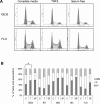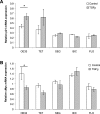Selective loss of TGFbeta Smad-dependent signalling prevents cell cycle arrest and promotes invasion in oesophageal adenocarcinoma cell lines
- PMID: 17264880
- PMCID: PMC1766472
- DOI: 10.1371/journal.pone.0000177
Selective loss of TGFbeta Smad-dependent signalling prevents cell cycle arrest and promotes invasion in oesophageal adenocarcinoma cell lines
Abstract
In cancer, Transforming Growth Factor beta (TGFbeta) increases proliferation and promotes invasion via selective loss of signalling pathways. Oesophageal adenocarcinoma arises from Barrett's oesophagus, progresses rapidly and is usually fatal. The contribution of perturbed TGFbeta signalling in the promotion of metastasis in this disease has not been elucidated. We therefore investigated the role of TGFbeta in Barrett's associated oesophageal adenocarcinoma using a panel of cell lines (OE33, TE7, SEG, BIC, FLO). 4/5 adenocarcinoma cell lines failed to cell cycle arrest, down-regulate c-Myc or induce p21 in response to TGFbeta, and modulation of a Smad3/4 specific promoter was inhibited. These hyperproliferative adenocarcinoma cell lines displayed a TGFbeta induced increase in the expression of the extracellular matrix degrading proteinases, urokinase-type plasminogen activator (uPA) and plasminogen activator inhibitor 1 (PAI-1), which correlated with an invasive cell phenotype as measured by in vitro migration, invasion and cell scattering assays. Inhibiting ERK and JNK pathways significantly reduced PAI and uPA induction and inhibited the invasive cell phenotype. These results suggest that TGFbeta Smad-dependent signalling is perturbed in Barrett's carcinogenesis, resulting in failure of growth-arrest. However, TGFbeta can promote PAI and uPA expression and invasion through MAPK pathways. These data would support a dual role for TGFbeta in oesophageal adenocarcinoma.
Conflict of interest statement
Figures








References
Publication types
MeSH terms
Substances
Grants and funding
LinkOut - more resources
Full Text Sources
Medical
Research Materials
Miscellaneous

